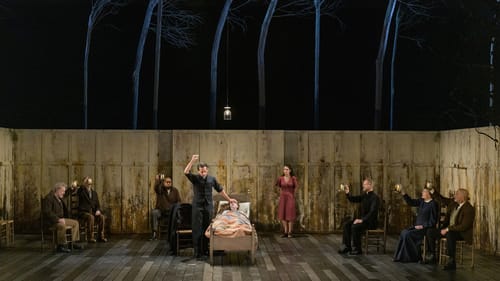Stay in the Loop
BSR publishes on a weekly schedule, with an email newsletter every Wednesday and Thursday morning. There’s no paywall, and subscribing is always free.
A chilling distillation
The Resident Ensemble Players present Arthur Miller’s ‘The Crucible’

Many witch hunts, literal and metaphorical, are historically codified, but two that resonate strongly in the American psyche are those for accused witches in the 17th-century Massachusetts Bay Colony and for communists in 20th-century Washington, DC. The Crucible, written in 1953 during the McCarthy era, conjures our colonial past as a contemporary metaphor. But a beautiful, haunting production by the Resident Ensemble Players (REP) proves that even after 70 years, the play still chillingly distills the past for the present and future.
Playwright Arthur Miller (1915-2005) was no stranger to controversy and deep dives into the American psyche. He used the fury of misguided fervor in the Salem witch trials to explore the inexorable juggernaut when suspicion meets human weakness.
The accusations
The play opens with a bevy of teenage girls—led by fearless, feckless Abigail Williams (Maria Guiver)—dancing in the forest, something forbidden by puritanical colony elders. The girls are discovered by the upright Reverend Samuel Parris (Mic Matarrese), and they try to extricate themselves from his censure by accusations of demonic possession and witchcraft.
Against this hysteria, Miller sets a trinity of characters representing normalcy. Rebecca Nurse (Kathleen Pirkl Tague) is the colony’s embracing midwife. Reverend John Hale (Michael Gotch), called in to investigate the allegations of witchcraft, is an enlightened cleric seeking a theological guide through the maze of superstition. And John Proctor (Rene Thornton, Jr.) is a respected farmer who holds himself above the townspeople’s bickering and maneuvering.
But Proctor is compromised by a moment of sexual weakness: during the post-childbirth illness of his wife Elizabeth (Jacqueline Correa), he slept with the seductive, besotted Abigail, whose forest dance was actually a conjuring session to curse Elizabeth, the woman in her way. Miller’s tangled and tragic web is threaded with property debates, sexual frustration, fear, religious fervor, and the suffocation of a closed society. It cannot end well, and it does not.
Highly fictionalized, this play is a bold challenge to what Miller saw as the heinous work of the House Un-American Activities Committee. Because this investigation and the witch trials are subjects of history, The Crucible carries the implacable weight of allegory and dual millstones of history and histrionics.
An operatic staging
Irish director Ben Barnes—former head of Dublin’s famed Abbey Theatre and also an opera director—acknowledges this freight and meets the challenge head on. His response to the work’s massive themes is to stage The Crucible operatically. Music both period and original (by Rob Milburn and Michael Bodeen) is heard throughout. The cast is clothed (by Mattie Ulrich) in costumes that adeptly quote both historical eras without bending solely to either. And Matthew Richards has designed swaths and pools of light that open up the spaces or render them claustrophobic.

But most operatic is Bill Clarke’s magnificent set. Marching across the back of the stage is a stand of withered trees, bent to the left as if by an ill wind. Steel gray walls spotted with corrosion fly or glide with menace. And suspended from the left and right proscenium are see-through sculptural black tormentors (traditionally a curtain to mask entrances and exits) that evoke birds of prey or witches in flight.
From the firmament
This setting provides Barnes and his 21-member cast (16 professionals and five students) an imposing architecture within which to meet the demands of Miller’s text, crafted of contemporary American speech larded with archaic usage of a bygone time. Crowd scenes can be played large-scale, though in some scenes there is a loss of intimacy that would be a chilling counterpoint to the mounting frenzy. The actors’ challenge, to which they and the director rise heroically, is that Miller starts the play at fever pitch. There is little time—and perhaps no need—for players to build dramatically realistic characters, though Pirkl Tague, Gotch, and Stephen Pelinski (as Deputy Governor Danforth) are able to convey compelling backstories.
Written at the height of Miller’s career, The Crucible is now in the firmament of the theatrical canon. But its 1953 opening (a Jed Harris production starring E.G. Marshall) was not favorably received by either critics or playwright. There have been two starry 21st-century Broadway revivals—with Liam Neeson and Laura Linney (2002), and Ivo van Hove’s production (2016) with Ben Whishaw and Saoirse Ronan and an original score by Philip Glass (currently feted by The Annenberg’s #Glassfest).
A challenging refresher
I must confess that this is my least favorite Miller play. As an allegory that probes the strictures of a stringent theocracy, the perils of conformity, and the hysteria of a closed society, it is a strident polemic, and its veiled misogyny resonates uncomfortably with the playwright’s own troubled, broken marriage to Marilyn Monroe.
John Proctor says, “We are what we always were, but naked now. And God’s wind will blow.” It is a bleak universe that Miller creates, but Barnes refreshes this challenging play and enlightens us with operatic winds from beyond our borders.
What, When, Where
The Crucible. By Arthur Miller. Directed by Ben Barnes. Through March 22 at the University of Delaware’s Roselle Center for the Arts (Thompson Theatre), 110 Orchard Rd., Newark, DE. (302) 831-2204 or rep.udel.edu.
The Thompson Theatre in the Roselle Center is a wheelchair-accessible venue. To learn more or request accommodations, call the box office or email [email protected] at least five days in advance of the performances. This production contains strobe lighting and theatrical haze.
Sign up for our newsletter
All of the week's new articles, all in one place. Sign up for the free weekly BSR newsletters, and don't miss a conversation.

 Gail Obenreder
Gail Obenreder